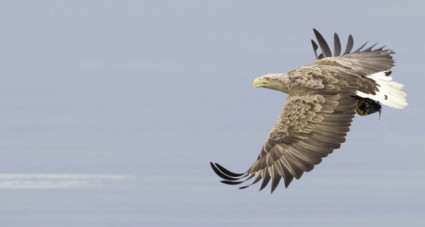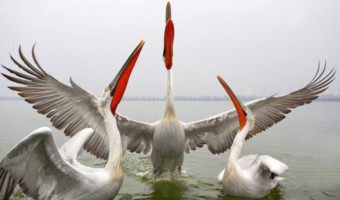
For at least three generations, no one living in The Netherlands had seen a wild bison roaming along the coastal dunes. Now, for the past decade, a herd of European Bison — the largest living land mammal in Europe — are thriving.
Across the continent, there are nearly 7,000 of the creatures remaining.
In Spain, biologists are reintroducing the Iberian Lynx back into the wild. A decade ago, there were fewer than 100 living. Now, thanks to careful stewardship, there are 300 of the big cats on the land, mostly in Andalucia. And in Scotland, beaver have now been re-introduced, centuries after they were hunted to extinction.
This is the phenomenon of ‘rewilding’ — bringing back species that were once common but have long-since disappeared or are under the threat of extinction.
It’s a controversial policy, one that often puts the animals at odds with landowners and farmers — but it is working, and sometimes with very quick and positive results.
In the United Kingdom, Rewilding Britain, an environmental organisation founded in 2015 with the aim of bringing back lost or near-extinct native species of fish, animals and birds, believes that 20 species including wild boar, wolves, eagles and moose could be brought back to its wild and open spaces.
The organisation believes rewilding provides hope for the future and can breathe life into the UK’s natural landscapes and struggling rural communities. Through rewilding, humans can start to reverse centuries of ecological damage., and it can create new opportunities.
“We have the opportunity right now to choose rewilding in some parts of the country. If we can get the scale right, and learn from people on the ground, we can chart a course to better times,” the organisation says.
“Rewilding is about abundance,” explains Rebecca Wringley, the chief executive at Rewilding Britain. “That doesn’t just mean more trees but an abundance of all nature. Insects and small animals flourish when flowers, plants and fungi flourish. They then become fodder for further up the food chain.”
Rewilding leaves nature to shape the landscape. The beaver is a flamboyant part of that — creating dams and ponds with their precision nibbling, which support a range of wildlife and prevent flooding. Other important land shapers include the lynx and wolf.
“A rewilded landscape restores living systems so they start working as they should,” Wringley tells Weekend Review. “This means deer can live in the woodlands where they belong, in numbers that the land can sustain, and not rely on people feeding them.”
She said that there are remnants of native rainforest in Britain. “These last patches of Atlantic oak woodland, like Coed Felinrhyd in Wales, are rich habitats of tree, lichen, moss and fern,” she said. “We could see these amazing habitats expand through rewilding.”
Many native woodlands in Britain are dying, usually due to deer or sheep grazing on young tree shoots. Where woodland is regenerating, you can see baby trees, toddlers, young adults and old yins — and that needs to be encouraged, Rewilding Britain says.
The case of the re-introduction of the Beaver back into Scotland is the UK’s first experience — and highly successful it is — of rewilding, says Dr Sarah Taylor, a lecturer in ecology at Keele University in Staffordshire, England.
“The Eurasian beaver (Castor fiber) was hunted to extinction in Scotland in the 16th century and was reintroduced,” she says. “This is the first time that a mammal has been formally reintroduced in UK history.”
Beavers are considered to be a keystone species, one whose very activities have an immediate effect on both the landscape and the natural habitats of other animals in the wild. Change that, and the habitat improves. By modifying their surroundings through coppicing, feeding and, in some cases, damming, beavers create ponds and wetlands which attract other species, provide a food source to others, and can even help improve water quality.
The Royal Zoological Society of Scotland, in partnership with the Scottish Wildlife Trust and Forestry Commission Scotland, released the first beavers to live in Scotland in over 400 years in May 2009. This marked the first formal reintroduction of a native mammal species in the UK and the beavers were monitored closely for a five-year period between 2009 and 2014.
The beavers have thrived, and there are now active colonies on the River Tay. Indeed, at the far end of Britain, in Devon, there is now a flourish colony of the creatures.
Indeed, as Dr Taylor notes, “one of the major challenges was the impact of beavers on forest crops. The [initial five-year] trial aimed to quantify this. There were also losses of beavers due to dogs’ attacks, and containment issues as one beaver left the trial area.”
Similar initiatives are taking place across Europe, with more than 200 formal beaver reintroduction projects in more than 26 European countries.
Perhaps the best example of re-wilding comes from the US.
The Mexican wolf is the rarest subspecies of gray wolf in North America. Once common throughout portions of the southwestern United States, the Mexican wolf was all but eliminated from the wild by the 1970s. In 1977, the United States Fish and Wildlife Service initiated efforts to conserve the species. In 1998, Mexican wolves were released to the wild for the first time in the Blue Range Wolf Recovery Area within the Mexican Wolf Experimental Population Area. Missing from the landscape for more than 30 years, the howl of the Mexican wolf can once again be heard in the mountains of the southwestern United States.
“Wolves are predators, which can lead to conflicts with landowners and other users,” Dr Taylor says. “Five dogs were reported as injured by wolves and there have been 49 confirmed fatal livestock depredations. It was loss of livestock that drove the original extirpation of the wolves in the first place.”
Mick O’Reilly is the Gulf News’ foreign correspondent based in Europe.













